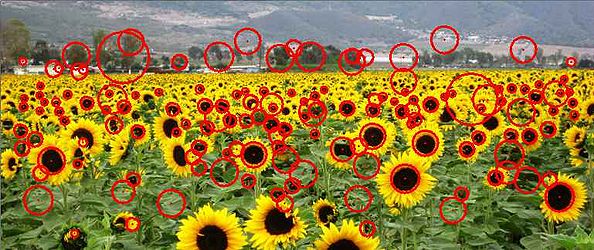Example Detect Interest Points
Detect Interest Point Example
Interest points are a general term in computer vision for points in the image that can detected and are relevant for higher level processing. Interest points are commonly used by image stabilization and structure from motion applications to track how the image changes from frame to frame. The following example shows how interest points can be detected easily using the InterestPointDetector<T> interface.
InterestPointDetector is a generalized interface that allows the user to switch between different types of interest points. Functions are provided that can be used to test if it provides scale and/or orientation information on the interest point. The disadvantages of using this interface is that it prevents tight coupling between algorithms, leading to excessive computations.
Example Code:
Concepts:
- Point feature detection
Relevant Applets:
Example Code
public class ExampleInterestPoint {
public static <T extends ImageBase>
void detect( BufferedImage image , Class<T> imageType ) {
T input = ConvertBufferedImage.convertFrom(image,null,imageType);
// Create a Fast Hessian detector from the SURF paper.
// Other detectors can be used in this example too.
InterestPointDetector<T> detector = FactoryInterestPoint.fastHessian(10, 2, 100, 2, 9, 3, 4);
// find interest points in the image
detector.detect(input);
// Show the features
displayResults(image, detector);
}
private static <T extends ImageBase> void displayResults(BufferedImage image,
InterestPointDetector<T> detector)
{
Graphics2D g2 = image.createGraphics();
FancyInterestPointRender render = new FancyInterestPointRender();
double detectorRadius = detector.getCanonicalRadius();
for( int i = 0; i < detector.getNumberOfFeatures(); i++ ) {
Point2D_F64 pt = detector.getLocation(i);
// note how it checks the capabilities of the detector
if( detector.hasScale() ) {
double scale = detector.getScale(i);
render.addCircle((int)pt.x,(int)pt.y,(int)(scale*detectorRadius));
} else {
render.addPoint((int) pt.x, (int) pt.y);
}
}
// make the circle's thicker
g2.setStroke(new BasicStroke(3));
// just draw the features onto the input image
render.draw(g2);
ShowImages.showWindow(image, "Detected Features");
}
public static void main( String args[] ) {
BufferedImage image = UtilImageIO.loadImage("../evaluation/data/sunflowers.png");
detect(image, ImageFloat32.class);
}
}
